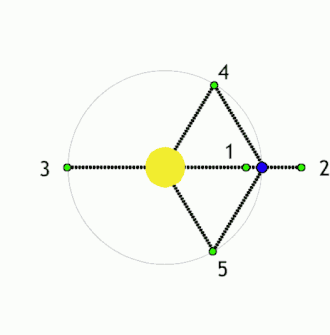Lagrange point
Jump to navigation
Jump to search
English
[edit]
Alternative forms
[edit]Etymology
[edit]
Named after Joseph Louis Lagrange, who discovered the points L4 and L5, building on earlier work by Leonhard Euler, and in 1772 published an essay on the three-body problem.
Noun
[edit]Lagrange point (plural Lagrange points)
- (astrophysics, orbital mechanics) A point in an orbital configuration of a two-body system where a small object affected only by gravity can theoretically be stationary relative to the two larger objects.
- Mathematically, the Lagrange points represent solutions to a restricted form of the three body problem in which the mass of one object is assumed negligible compared to that of the two principal bodies—as, for example, an artificial satellite and the Earth-Moon system.
- 2008, David Schrunk, Burton Sharpe, Bonnie L. Cooper, Madhu Thangavelu, The Moon: Resources, Future Development and Settlement, Springer, Praxis Publishing, page 57:
- Lagrange points are significant for lunar development in that raw materials, such as near-Earth objects (NEOs) can be safely stored at L-4 and L-5 prior to mining and processing.
- 2013 July 28, Megan Gannon, “Spacecraft Sees Giant 'Hole' In the Sun”, in news.yahoo.com[1], retrieved 2013-07-29:
- The $1.27-billion (1 billion euros) SOHO satellite was launched in 1995 and is flying a joint mission between NASA and the European Space Agency (ESA). It watches solar activity from an orbit about the Lagrange Point 1, a gravitationally stable spot between Earth and the sun that is about 932,000 miles (1.5 million kilometers) from our planet.
Synonyms
[edit]- (astrophysics): L-point
Hypernyms
[edit]- (astrophysics): libration point
Hyponyms
[edit]- (astrophysics): Trojan point
Derived terms
[edit]- (astrophysics): Lagrangian, Lagrangian asteroid, Lagrangian moon, Lagrangian planet
Related terms
[edit]Translations
[edit]point in an orbital configuration
|
See also
[edit]- (astrophysics): barycenter
